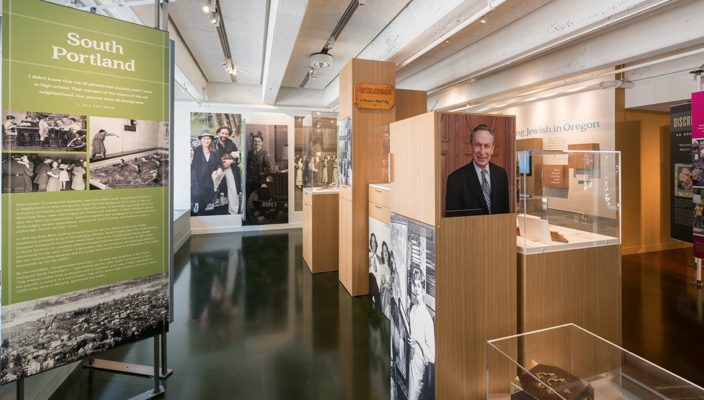Curator: Anne LeVant Prahl, OJMCHE Curator of Collections
Oregon Jewish Stories documents the experience of Oregon’s Jewish community from its beginnings in the Gold Rush era of the 1840s through today. It explores the questions of identity that many Oregon Jews wrestle with and explores the experience of Jews throughout the state. The four key take-home messages of the exhibition can be expressed as:
- Jews were among the first immigrant groups to travel to the Oregon territories. The Jews who chose, and still choose, to come to Oregon are a self-selecting group of people who are inclined toward self-starting, entrepreneurial endeavors. They bring to their civic and Jewish lives a willingness to start from scratch and make the experience their own.
- Jews for the most part have found opportunities in the American West; opportunities unavailable to them in other regions of America and certainly unavailable to them in the countries that they left behind.
- Oregon Jews must seek a balance between maintaining religious and cultural traditions and finding a place within the majority population. There are common threads between this process and the process other cultural and ethnic groups find themselves going through.
- Many Jews have responded to expanded opportunities by participating in civic life, often fighting for legislation protecting civil liberties. Jews have helped to shape civic life in Oregon.
Oregon Jewish Stories tackles these themes in three sections. First, the question of identity is posed to the viewer. We ask questions about how we define ourselves – are you an Oregon Jew? A Jewish Oregonian? Are you politically active? Gay? Straight? Complicated? And then we ask what culture looks like. Do you express your culture through food, through art, through your clothing or language? What form does it take and what are you saying about your culture and yourself? These are questions that each successive generation of Oregon Jews has considered.
The second section of the exhibition chronicles the major waves of influx to Oregon over the years, beginning with the earliest arrival, in the late 1840s, of Jews from Central Europe, mainly from Prussia and Bavaria. These were young, intrepid men who came to seek their fortunes by becoming merchants to the miners in Southern Oregon and eventually became shopkeepers, farmers, and businessmen throughout the state. Next came the Eastern Europeans and the Sephardim, from the Isle of Rhodes and Turkey. These Jews came at the turn of twentieth century as families. They had family connections, bringing relatives and neighbors after them to create a neighborhood of immigrants in South Portland. The 1930s and 40s brought first refugees from Nazi-occupied Europe and then survivors of the Holocaust. Each group had its own challenges and each immigrant has an individual story to tell. In the 1990s the Jews were finally permitted to leave Soviet Russia. They are followed, in the twenty-first century, by transplants from across the United States who have flocked to Oregon and created new synagogues and forged a new Oregon Judaism.
The third section of the exhibition examines the lives of these groups of Jews as they find their way in the state. With panels on topics such as “Making a Living” and “Working the Land” or “The Emergence of Women’s Roles,” this section addresses many areas of Jewish life in Oregon and how they have changed over time.
Oregon Jewish Stories relies on the museum’s large photograph collections and images documenting the experiences of Oregon’s Jewish community can be found throughout.
